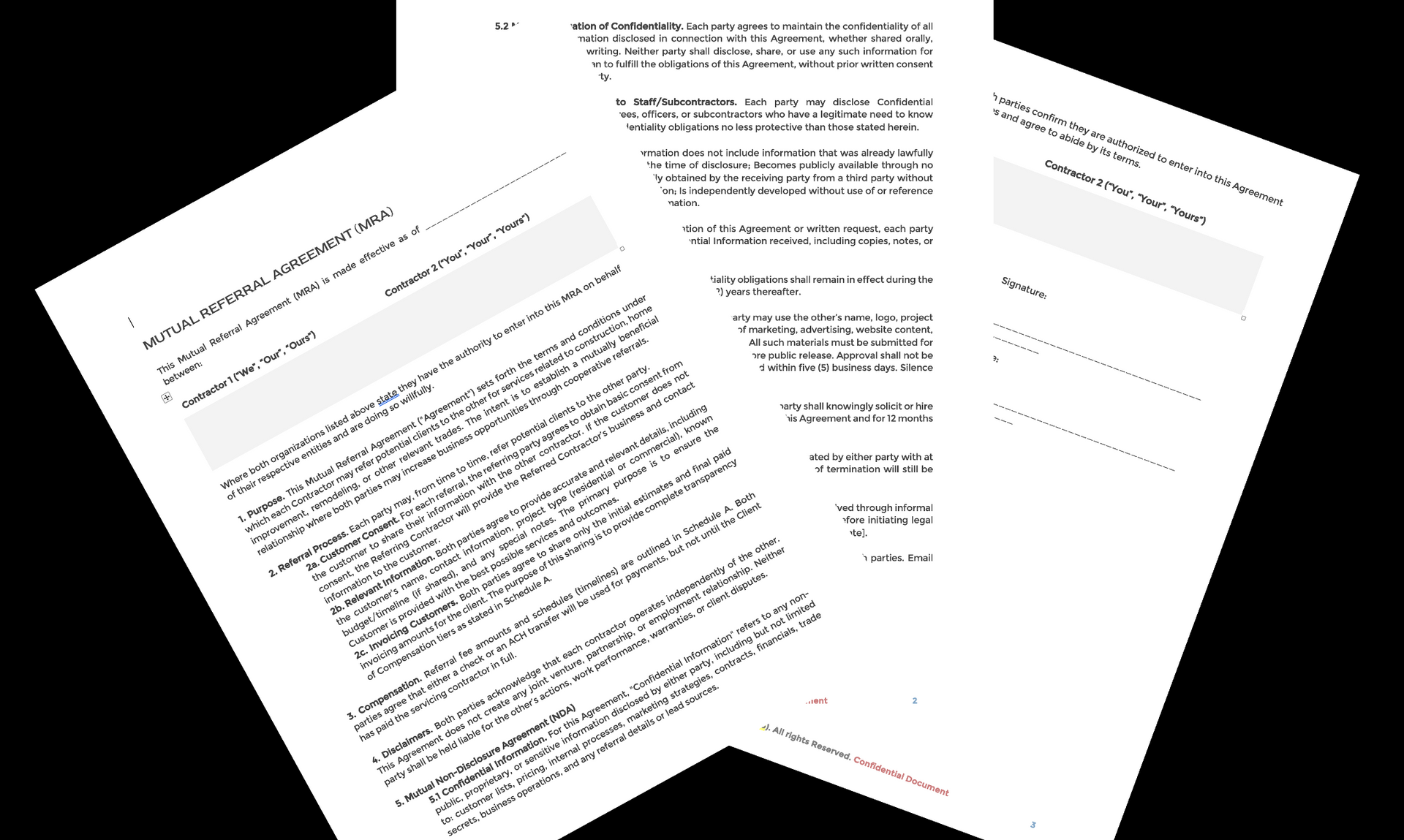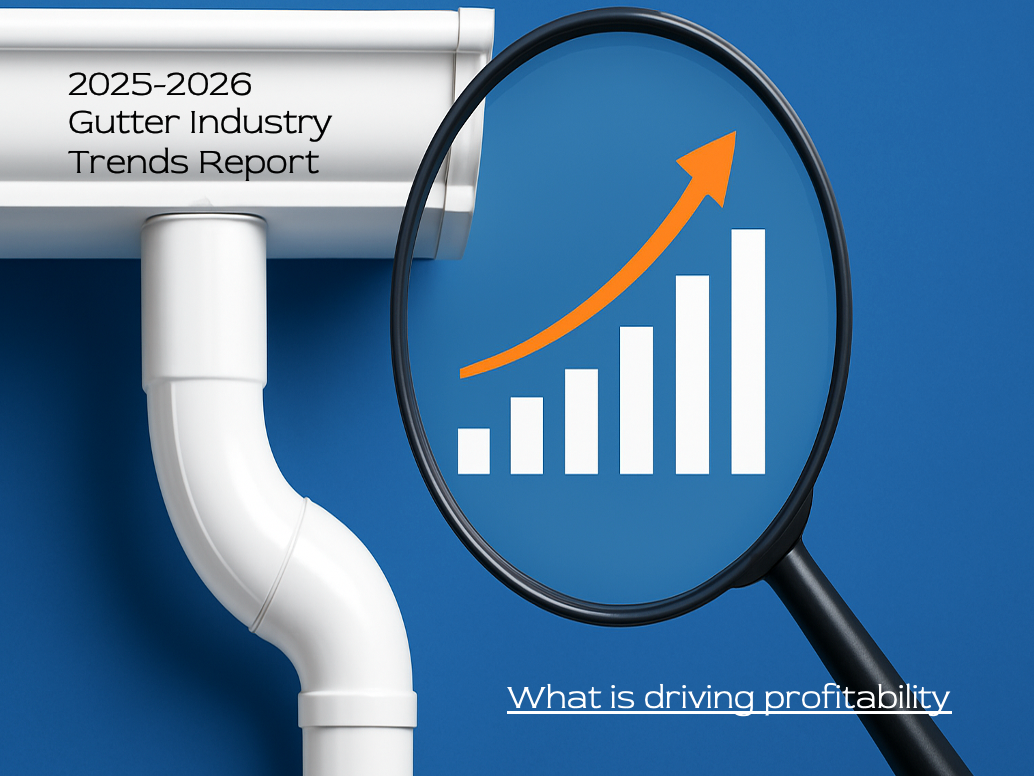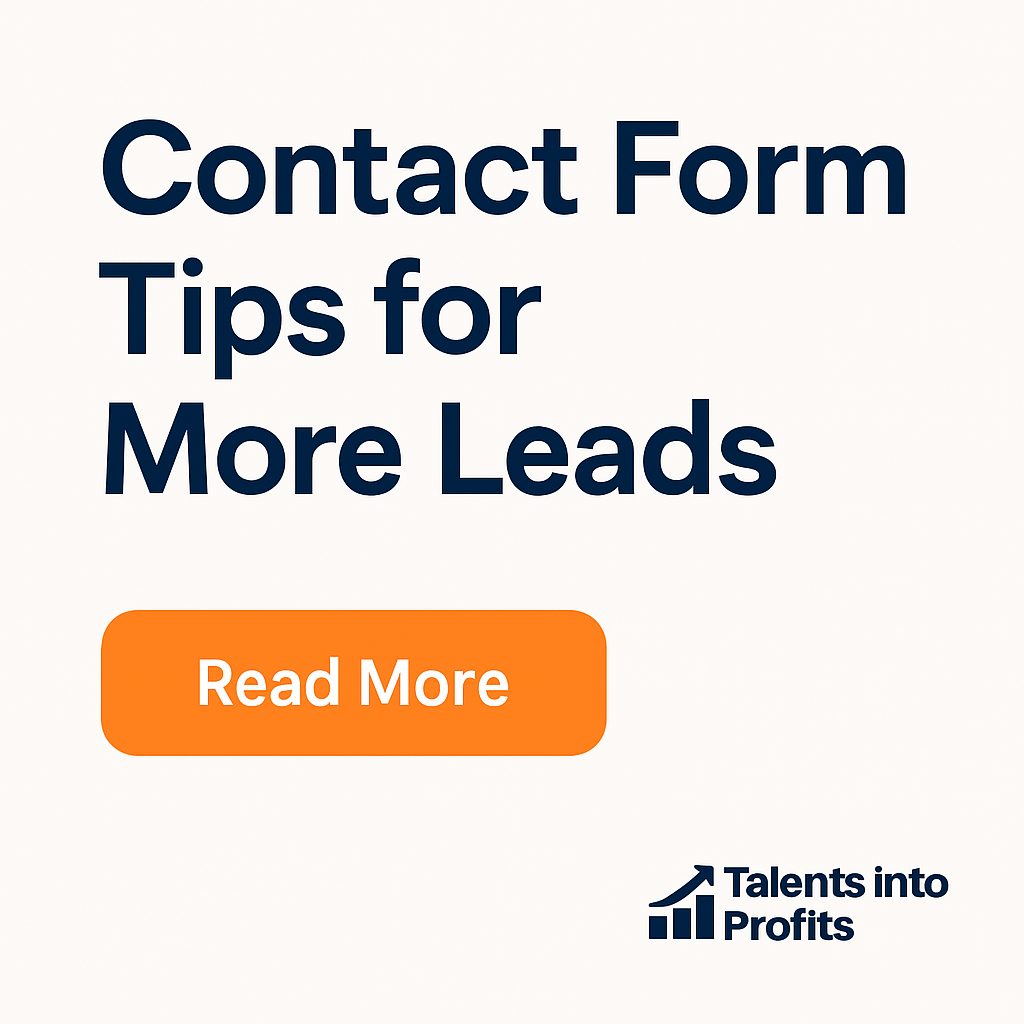How to Get more Contractor Referrals
Build your Customer and Contractor-to-Contractor Referral Program
Includes Referral Template outline to follow or copy/paste
Will Schmidt - November 4, 2024
Referral Strategy Guide Summary
If you’re a contractor juggling bids, job sites, and endless follow-ups, having the right referral system isn’t just helpful—it’s a total game-changer. Think about this: 82% of small businesses say referrals are their main source of new customers, and companies that actually put effort into referral marketing often grow revenue by more than 86%. Oh, and those referred customers? They’re gold. They usually spend about 16% more over their lifetime compared to people who just found you online.
In this guide, we’ll break down how to crank up your referrals—whether they come from happy customers or other contractors in your network. You’ll get practical tactics, clever incentives, word-for-word scripts, and real examples across the trades: gutters, metal roofing, roofing, plumbing, HVAC, restoration, construction, and landscaping. Each industry has its own accordion section below, so you can jump right to what fits your business.
Whether you’re building your very first referral program or tuning up one that’s been running on autopilot, grab a coffee (or pour yourself a whiskey if that’s your style) and let’s dive in.
Sections and Topics
- Introduction & Quick Summary
- Deliver a 5-Star Customer Experience
- Don’t Be Shy — Ask for Referrals (and Make It Easy)
- Start a Referral Rewards Program
- Build a Network of Contractor Partners
- Build a Personal Network of High Earners
- Track & Scale Your Referrals
- The Top Mistakes in Build a Referral Program
- Contractor-to-Contractor Referral Agreement Template
- How TIP can help
Exceed Customer Service Expectations for more Referrals

Word of Mouth still trumps paid advertising
Referrals start with great service. Exceed client expectations at every step. Most residential construction referrals happen during the warranty period, so follow‑up is critical. Quality work, professionalism, and empathy turn clients into raving fans and prime them for referrals.
Click your industry to find your example and suggestion:
Gutters:
Arrive on time, protect landscaping, and leave the job site spotless. Send a hand‑written thank‑you card and a coupon for future gutter cleaning. Include a free downspout extension or splash block as a nice bonus.
Metal Roofing:
Clearly explain the benefits (e.g., wind and fire resistance, energy savings) and provide before‑and‑after photos. Offer a complimentary inspection one year later to ensure fasteners and sealants are secure.
Roofing:
Move plants and cover gardens, use magnets to pick up nails, and sweep driveways when finished. Small gestures—like clearing gutters and patios—show respect for the homeowner’s property.
Plumbing:
Respect clients’ time and space. Wear boot covers, use drop cloths, and explain pricing upfront. Test all fixtures before leaving and share preventive tips (e.g., don’t pour grease down drains).
HVAC:
Use plain language when explaining repairs or upgrades. Show customers how to change filters and set thermostats. Suggest energy‑saving options like smart thermostats or zoning systems.
Restoration:
Be compassionate and transparent. Outline the process, coordinate with insurance adjusters, and provide frequent updates. In crises, empathy builds trust and future referrals.
Construction:
Keep projects on schedule and budget. Share weekly progress reports with photos. If delays arise, communicate honestly and adjust timelines transparently.
Landscaping:
Deliver neat edges and thriving plants. Choose species that suit the climate, and provide aftercare instructions. Schedule a follow‑up visit a month later to check on plant health.
Ask for referrals from everyone, everytime, with the right tone

Confident referral request with an incentive
A gentle nudge can dramatically increase your referral rate. People are more likely to refer when asked, especially when there’s a reward. Ask at the right moment—right after you’ve delighted your client—and make it easy for them to refer.
Gutters:
Offer $25 off a future cleaning for each new client referred. Include the coupon on your final invoice or thank‑you email.
Metal Roofing:
Give clients referral cards with a personal note. Send a coffee gift card or offer a free roof inspection when a card leads to a new job.
Roofing:
Check in after the first rain. If they’re thrilled, ask if they know anyone whose roof leaks. This follow‑up shows you care and prompts referrals.
Plumbing:
Leave a branded magnet or notepad on the fridge so your contact details are always handy. Follow up a few weeks later to ask if everything is working smoothly and remind them of your referral offer.
HVAC:
Offer $50 off the next tune‑up for every friend who signs a maintenance plan. This ties referrals to recurring revenue.
Restoration:
At the final walkthrough, ask if they know neighbors dealing with damage. Offer a free moisture scan for anyone they refer.
Construction:
Provide cash or discount bonuses (e.g., $250 off a future remodel) for referrals that turn into signed contracts.
Landscaping:
Run a “Yard of the Month” contest. Each referral earns the client an entry to win free fertilization, aeration, or snow removal.
Gutter Marketing - How to Get More Gutter Leads
Start a Customer Referral Rewards Program

Gutter Installation vs Gutter Cleaning Cities
A structured program with clear incentives increases referral participation. More than half of people say they’re more likely to refer a friend if offered a reward. Tailor your program so both referrer and new customer benefit.
Gutters:
Offer tiered discounts: 10 % off the next cleaning for one referral, 20 % for two, and a free cleaning after three.
Metal Roofing:
Reward referrers with upgrades, like free snow guards or extended warranties on existing roofs.
Roofing:
Donate $100 to a charity of your client’s choice for each referral. Many homeowners appreciate a philanthropic gesture more than a personal incentive.
Plumbing:
Give a $75 credit toward future work or an annual inspection for every new client referred.
HVAC:
Provide a free box of air filters when a friend purchases a new system. Filters are inexpensive but valuable to homeowners.
Restoration:
Send gourmet gift baskets or house‑cleaning vouchers when a referral converts to a job. This personal touch is memorable.
Construction:
Offer upgrade credits toward premium materials (e.g., countertops, flooring) on future projects for each successful referral.
Landscaping:
Give a free seasonal service—like aeration, fall cleanup, or snow removal—for each referral that becomes a client.
Build a Contractor-to-Contractor Referral Program

Contractors are the fastest way to double your exposure
Nearly half of builders rely on referrals for most of their sales—and not all of those come from clients. Team up with complementary trades so you can pass leads back and forth. Clearly outline expectations, referral fees (if any), and communication protocols.
Gutters:
Look for roofers, metal roofers, painters, and landscapers. They see the water damage, the problems with gutters, and you can get not only gutter installation jobs but gutter guard jobs as well.
Metal Roofing:
Partner with solar installers. Offer a “roof + solar” package, and refer clients to each other. Or consdier gutter companies and other roofing companies that don't offer metal roofing. Painters are always very astute at noticing problems with the exterior of homes.
Roofing:
Build referrals with gutter companies, window companies, exterior painters and landscapers. These companies see the problems from bad roofing that lead to the jobs they were called for in the first place.
Plumbing:
Partner up with HVAC companies, cabinet makers, flooring specialists, house cleaners, restoration companies, and handymen. All of these companies work inside the home.
HVAC:
Partner up with plumbing companies, cabinet makers, flooring specialists, house cleaners, restoration companies, and handymen. All of these companies work inside the home.
Restoration:
Since you work on both the inside and outside of homes, partner up with companies that you can subcontract work out. This makes you a general contractor, your payorll remains low and you have an expert for cabinets, flooring, plumbing, construction, roofs, gutters, and more.
Construction:
Since you work on both the inside and outside of homes, partner up with companies that you can subcontract work out for large home builds and remodels. This will keep your margins safe and also makes you a general contractor, your payorll remains low and you have an expert for cabinets, flooring, plumbing, construction, roofs, gutters, and more.
Landscaping:
The beauty of being a landscaper is that all contractors want to work with you. So literally choose two from every exterior type of construction and partner up. This will make you even more valuable and help you not only make referral money, get leads, but retain your customers longer.
Build a Network of High Earners for bigger Jobs

People who make more money give higher paying referrals
Every person who makes a lot of money likely has a property and at one time will need your company and services. Don't wait for the next $500 job referral when a higher earning individual has a network of people who need $15,000 to $100,000 jobs filled.
Not all referrals are created equal. A happy client might send you their cousin who needs a small repair — great for filling gaps in your schedule. But if you want game-changing referrals, you need to build relationships with people who are plugged into wealthier circles and bigger projects. Think real estate agents, insurance adjusters, property managers, or even financial advisors. These people can refer you to high-value clients again and again.
The key is to add value first. Invite them to lunch, swap leads, co-host a workshop — show that referring you makes them look good. Over time, a handful of these “power connectors” can produce more revenue than dozens of one-off referrals. In fact, studies show that referrals from professional networks convert 70% faster and at higher ticket sizes than cold leads.
Build a Software System to Track your Referrals

Paying out referrals, getting paid by referrals is easier when you have a CRM tracking system
What gets measured gets improved. Track who refers whom, what incentives work, and how much revenue each referral generates. This data lets you double down on what’s working and ditch what isn’t.
Clients and Referral Sources are in the CRM
A good CRM gives you a single dashboard where every client interaction is logged. Instead of flipping through spreadsheets or old texts, you can see at a glance who referred the client, when they came in, and what stage of the project they’re at. Having a “Referral Source” field means you’ll never again have to guess whether that lead came from a buddy in roofing or a customer’s cousin who shared your name at a BBQ. Over time, patterns emerge — you’ll see which referral partners bring you steady, high-value work, and which ones just send the occasional tire-kicker.
This isn’t just about attribution; it’s about action. When your CRM tracks the source of every deal, you can sort and filter by referral type. That lets you run campaigns like “send thank-you gifts to my top 10 referral partners” or “call every past client who gave me a referral last year.” Without a system, these opportunities slip through the cracks. With one, you’re methodical — which is why companies that use CRMs boost referral conversions by as much as 35% compared to those running blind.
You can automate the bonus formulas with CRMs
Referrals often mean money changes hands — whether it’s a cash bonus, a discount, or a gift card. Tracking those promises manually is a recipe for disputes or forgotten rewards. A CRM lets you tie the actual invoice amount to the referral record and then apply formulas for payouts. For example, you can set a rule: “Give 5% of project revenue back as a referral reward.” When the invoice closes, the CRM calculates it automatically. No guessing, no napkin math, no awkward conversations about underpayment.
This transparency matters because it builds trust. If your referral partners know they’ll get paid on time and accurately, they’ll keep sending you leads. On the flip side, if you “forget” or miscalculate, referrals dry up fast. By automating payouts through CRM fields and formulas, you turn goodwill into a reliable program. It also makes tax time simpler, because you’ll have a clear log of referral payouts — something your accountant (and the IRS) will appreciate.
Or you can build your own in Google Sheets
Not every contractor needs a $500/month CRM subscription. The truth is, you can build a lean but powerful referral tracking system inside Google Sheets. With dropdowns for referral source, project status, invoice total, and payout percentage, you’re basically running a CRM-lite that’s familiar to your team. Add conditional formatting (like red highlights for overdue payouts) and you have a live referral dashboard accessible from any device.
The beauty here is cost and simplicity. Google Sheets is included in Workspace (around $6–12/user per month), which most contractors already use for email and files. That means no new software to learn, no vendor lock-in, and no recurring CRM bill. Plus, you can link Sheets to Google Forms so clients and partners can submit referrals online, which auto-populates your tracking sheet. It’s DIY, but for many small to mid-size teams, it’s more than enough to keep referral programs organized and effective.
CRMs can calculate your Referral ROI
A great CRM gives you hard data: how many referrals came in, how many converted, what revenue they brought, and what rewards were paid out. This isn’t just bragging rights; it’s the backbone of scaling. Imagine knowing that every $100 you spend on referral bonuses brings you $1,000 in closed deals. With reports, you can justify increasing your rewards program — and you can clearly show partners the value of working with you.
Reporting also keeps you focused. Without metrics, referral programs can drift into “nice-to-have” territory, always overshadowed by ads or cold calls. With a dashboard proving referrals account for, say, 30% of new revenue, you can confidently prioritize them. It also gives you leverage when talking to partners: “Hey, last year I paid out $15,000 in referral bonuses. Stick with me, and you’ll keep cashing checks.” That kind of proof turns your referral program from casual to professional.
Even QuickBooks can do this for you
QuickBooks isn’t just for balancing books — it can double as a simple referral tracking tool when set up correctly. By creating custom fields in your invoices and customer records (like “Referral Source”), you can tag every new client with where they came from. Once you run reports filtered by that field, you’ll know exactly how much revenue came from referrals versus ads, SEO, or repeat customers. QuickBooks also integrates with many CRMs and job-management tools, so you can automatically feed referral data into your accounting system without duplicate entry.
The biggest advantage is payment accuracy. If you pay referral bonuses as either expenses or vendor payments, QuickBooks creates a clear paper trail. You can attach the client invoice, note the referral source, and cut the bonus check all in one system. Come tax season, you’ll know exactly how much you spent on referral fees and can categorize them properly. It’s professional, transparent, and far more efficient than scribbling notes on invoices. For contractors already running QuickBooks, using it as the backbone of your referral program adds zero new software costs — and it keeps your finances and referral rewards in lockstep.
Top Mistakes in building a Contractor Referral Program
Even the best referral programs can flop if you step on a few landmines. Think of these as “contractor bloopers” in the business world — they’re avoidable, but once you trip, it’s tough to recover. Let’s break them down.
Asking for referrals too soon
Picture this: you’ve just started demo on a kitchen remodel, there’s dust in the air, and the homeowner’s dog is barking at your crew. That is not the moment to ask, “Hey, do you know anyone else who needs a contractor?” Asking for referrals before you’ve wowed a client is like proposing on the first date — awkward, premature, and likely to backfire. The right time is when the client is grinning ear-to-ear at the finished product, not when they’re staring at bare studs. Wait until they’re thrilled, then ask.
This isn’t just about attribution; it’s about action. When your CRM tracks the source of every deal, you can sort and filter by referral type. That lets you run campaigns like “send thank-you gifts to my top 10 referral partners” or “call every past client who gave me a referral last year.” Without a system, these opportunities slip through the cracks. With one, you’re methodical — which is why companies that use CRMs boost referral conversions by as much as 35% compared to those running blind.
When you're pushy, you look desperate
Nobody likes a salesman who feels like a telemarketer in work boots. Encouraging referrals is great; pressuring clients makes them cringe. It’s the difference between saying, “If you know anyone who needs help, feel free to pass along my card,” versus “I need five names from your address book before I leave.” The first builds goodwill, the second makes clients avoid your calls. Referrals thrive on goodwill, not guilt trips.
Don't neglect referral follow-up
You promised a referral reward. The client delivered. Then… crickets. No thank-you, no gift card, no follow-up call. Want to guarantee you never get another referral? That’s how you do it. Delays in rewarding referrers erode trust faster than a leaky roof in a storm. On the flip side, rewarding promptly and personally — even with just a handwritten note and a small bonus — makes clients feel appreciated. They’ll remember that feeling next time a friend asks for a recommendation.
The beauty here is cost and simplicity. Google Sheets is included in Workspace (around $6–12/user per month), which most contractors already use for email and files. That means no new software to learn, no vendor lock-in, and no recurring CRM bill. Plus, you can link Sheets to Google Forms so clients and partners can submit referrals online, which auto-populates your tracking sheet. It’s DIY, but for many small to mid-size teams, it’s more than enough to keep referral programs organized and effective.
Offering small or trivial rewards
If a client refers you a $20,000 roofing job and your “reward” is a $5 coffee coupon, you’ve basically said, “Thanks, but your effort is worth pocket change.” Ouch. Incentives need to match the job size. You don’t have to hand out gold bars, but a thoughtful, proportional thank-you goes a long way. A $250 credit on their next service, a nice dinner gift card, or even an upgraded warranty shows you value their referral. Cheap rewards feel cheap — and so does your brand if you go that route.
Reporting also keeps you focused. Without metrics, referral programs can drift into “nice-to-have” territory, always overshadowed by ads or cold calls. With a dashboard proving referrals account for, say, 30% of new revenue, you can confidently prioritize them. It also gives you leverage when talking to partners: “Hey, last year I paid out $15,000 in referral bonuses. Stick with me, and you’ll keep cashing checks.” That kind of proof turns your referral program from casual to professional.
Don't ignore unhappy clients, solve the problem
One unhappy client with a megaphone (or worse, a Google review account) can sink more referrals than you’ll ever count. Ignoring complaints is like ignoring a leaking pipe — it only gets worse. If a client isn’t happy, fix it. Call them, apologize, make it right. Not only might you salvage the relationship, but turning a negative experience into a positive one can actually create referrals. People love telling the story of “the contractor who went above and beyond to fix things.”
The biggest advantage is payment accuracy. If you pay referral bonuses as either expenses or vendor payments, QuickBooks creates a clear paper trail. You can attach the client invoice, note the referral source, and cut the bonus check all in one system. Come tax season, you’ll know exactly how much you spent on referral fees and can categorize them properly. It’s professional, transparent, and far more efficient than scribbling notes on invoices. For contractors already running QuickBooks, using it as the backbone of your referral program adds zero new software costs — and it keeps your finances and referral rewards in lockstep.
Improper Tracking and Timely Payments
Flying blind kills referral programs. If you don’t know who referred whom, how much revenue those jobs brought in, or what rewards you promised, you’re running on hope and sticky notes. Spoiler alert: hope isn’t a strategy. Whether you use a CRM, QuickBooks, or a Google Sheet duct-taped together with formulas, track everything. Data tells you which referral sources are gold mines and which ones are dry holes. Without it, you’ll never know what’s working — and you can’t improve what you don’t measure.
The Contractor Referral Program Template

Referral Agreements are Simple but Precise
- Parties: Contractor A and Contractor B (independent businesses).
- Purpose: Mutually refer customers when a lead falls outside the other party’s scope.
- Referral Process: When a referral arises, Contractor A gives Contractor B’s contact info to the client (and vice versa), then notifies the partner of the lead. Both agree to handle referred clients professionally.
- Referral Fee: Optional. If agreed, Contractor B pays Contractor A a set percentage (e.g., 5 %) or flat fee for any referred job completed, within a defined time after payment is received.
- Exclusions: Clarify job types covered and exclude pre-existing leads.
Term & Termination: Either party can end the agreement at any time with written notice, but outstanding referral fees remain owed. - Non‑exclusivity: Both parties may have other referral partners.
- Independent Contractors: The agreement doesn’t create a partnership or joint venture.
- Quality Assurance: Both parties commit to high standards and to resolving any issues with referred clients.
- Confidentiality: Both keep shared client info confidential.
- Governing Law: Specify the jurisdiction for legal matters.
Before, During, and After Video tips
Start filming video when you arrive to any job sites as your "before" moment and post as a short, "stay tuned for the lunch time walkthrough."
Then film mid-progress and final results, all as short videos. Then you could even combine them as one long project.
Ideas for Gutter Videos
- New jobs (any type)
- Gutter types
- Gutter colors
- Gutter Screens
- Gutter scams
Literally anything about the gutter industry. Just pick up that phone and start telling the world!
Turn Videos into conversions
YouTube isn’t just for views — it’s for conversions. Add:
- Clickable CTAs (end screens, pop-ups) linking to your website or a quote form.
- Pinned comments with your phone number and “Book your gutter service today.”
- Video descriptions with a strong first line CTA (since most people don’t expand the description).
- Cross-promote your videos by embedding them on your city landing pages and blogs — this boosts both SEO and trust.
Repurpose Videos
Listen, going viral isn't likely, but it happens occasionally. The key to YouTube is to keep producing content regularly, like every 1-2 weeks, and see what the audience enjoys. Then, focus on doing more videos similar to the ones people liked.
Respond to reshares and comments
Customers want recognition and search engines want to see your active on profiles. So within 4-8 business hours, respond to all online reviews using their name and thanking them for allowing you to help them. And if they didn't state what services you provided, you should state them as well.
How TIP can help with your referral Program
Building processes, agreements, and co-marketing
At TIP, we don’t just talk about referrals — we build the systems that make them work. From creating custom agreements between you and your contractor partners to designing simple Google-based CRMs that track every referral dollar, our goal is to turn word-of-mouth into a repeatable, measurable growth engine.
We help you outline the processes, draft airtight agreements, and even co-market with your referral partners so you both win more jobs. Think joint door hangers, co-branded social posts, or a shared review strategy — all backed by tracking so you know exactly what’s paying off.
Your reputation is already your best sales tool. TIP makes it easier to leverage, scale, and prove. If you’re ready to turn casual referrals into a predictable pipeline of customers, let’s build your program the right way.
Book a Consult today to learn about the Chief Strategy Officer Program, which includes full marketing and business development.
About the author
Will Schmidt
Will Schmidt, Founder and Owner of Talents Into Profits (TIP), has helped over 150 businesses across 17 different industries, including home services, healthcare, and SaaS, generating more than $11 billion in lifetime sales. His experience in providing branding, marketing, websites, and lead generation based on operational capacities has enabled his clients to continually see 20-50x monthly ROI for services rendered.
Subscribe to Blog
Sign up to get industry insights, trends, and more in your inbox.
Contact Us
We will get back to you as soon as possible.
Please try again later.
Book Free Consult
Join me for a 30-45 minute call to review how to grow your contractor business faster, more affordably, and easier.
SHARE THIS











